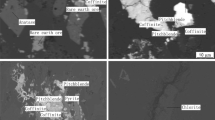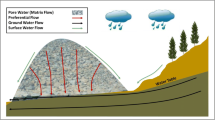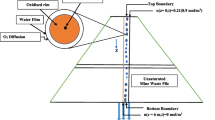Abstract
Heap leaching of precious metals from low-grade ores is modeled using the slow and fast zone concept of liquid movement in porous media (Kartha and Srivastava Transport in Porous Media 75, 227–247, 2008). The heap is conceptualized as a porous medium with the pores filled by liquid and/or air. The liquid phase is further divided into three zones—immobile, slow moving, and fast moving, with only the immobile and slow-moving liquids interacting with the solid particles. The conceptual model is applied to simulate two- dimensional leaching of a shallow gold ore heap. Temporal evolution of gold concentration in the solid and the liquid phases are analyzed to ascertain the effect of several parameters on the leaching process. Sensitivity analyses are performed with respect to the irrigation rate, the equilibrium sorption coefficient, and the fractional volume of the slow-moving liquid. For a constant volume of the leaching solution and for the same duration of leaching, the metal extraction is higher when a larger number of irrigation cycles are used. The metal extraction is found to be smaller for higher values of the sorption coefficient.
Similar content being viewed by others
Abbreviations
- Ω :
-
Volume of an individual finite-difference cell and/or arbitrary porous medium [M0L3T0]
- α im :
-
Solute mass transfer rate between slow and immobile liquid [M0L0T−1]
- α sf :
-
Solute mass transfer rate between slow and fast liquid [M0L0T−1]
- α*:
-
van-Genuchten’s parameter [M0L−1T0]
- ε :
-
Porosity of the media [M0L0T0]
- λ :
-
van-Genuchten’s parameter in computing permeability in Eq. (5) [M0L0T0]
- Δx :
-
Spatial step size for finite-difference scheme [M0L1T0]
- Δt :
-
Temporal step size for finite-difference scheme [ML−1T−1]
- ρ m :
-
Mass of gold per unit volume of porous medium [ML−3T0]
- ρ b :
-
Bulk density of the porous medium [ML−3T0]
- ρ l :
-
Density of liquid [ML−3T0]
- σ fs :
-
Saturation of the fast-moving liquid [M0L0T0]
- σim :
-
Immobile liquid saturation in the porous medium [M0L0T0]
- σ sl :
-
Saturation of the slow-moving liquid [M0L0T0]
- σ sle :
-
Effective slow liquid saturation in the porous medium [M0L0T0]
- A :
-
Area of cross section used in divergence theorem for integration [M0L2T0]
- C fs :
-
Solute concentration in fast-moving liquid [M0L0T0]
- C im :
-
Solute concentration in immobile liquid [M0L0T0]
- C sl :
-
Solute concentration in slow-moving liquid [M0L0T0]
- C 0 :
-
Solute concentration in the inflow liquid [M0L0T0]
- \({D^{\ast}_{\rm f}}\) :
-
Dispersion coefficient in fast liquid [M0L2T]
- \({D^{\ast}_{{\rm sl}}}\) :
-
Dispersion coefficient in slow liquid [M0L2T]
- F im :
-
Instantaneous sorption fraction in immobile zone [M0L0T0]
- F sl :
-
Instantaneous sorption fraction in slow liquid [M0L0T0]
- K im :
-
Immobile equilibrium sorption coefficient [M−1L3T0]
- K sl :
-
Equilibrium sorption coefficient in the slow liquid [M−1L3T0]
- L :
-
Characteristic length of column [M0LT0]
- M Au :
-
Mass of gold in porous medium [ML0T0]
- P l :
-
Liquid pressure in the column [ML−1T−2]
- Ṡ fs :
-
Liquid source term in the fast zone [ML−3T−1]
- Ṡ sl :
-
Liquid source term in the slow zone [ML−3T−1]
- S im1 :
-
Instantaneously sorbed solute concentration from immobile liquid [M0L0T0]
- S im2 :
-
Rate-limited sorbed solute concentration from immobile liquid [M0L0T0]
- S sl1 :
-
Instantaneously sorbed solute concentration from slow liquid [M0L0T0]
- S sl2 :
-
Rate-limited sorbed solute concentration from slow liquid [M0L0T0]
- T 0 :
-
Duration of input contaminant pulse at the top of the column [M0L0T]
- d :
-
Dispersivity [M0LT0]
- f :
-
Fraction of sorption site available for slow-moving liquid [M0L0T0]
- ĝ :
-
Acceleration due to gravity vector [M0LT−2]
- k rls :
-
Relative permeability for slow liquid [M0L0T0]
- k im :
-
Sorption rate in the immobile liquid [M0L0T−1]
- k sl :
-
Sorption rate in the slow liquid [M0L0T−1]
- k ps :
-
Slow permeability in the liquid zone [M0L2T0]
- k s :
-
Intrinsic permeability of the ore [M0L2T0]
- ̂n :
-
Unit outward normal vector [M0LT0]
- q :
-
Irrigation application rate [M0LT−1]
- \({{\vec{u}}_{\rm l}}\) :
-
Darcy discharge or Darcy velocity [M0LT−1]
- \({{\vec{u}}_{{\rm fs}}}\) :
-
Fast component of Darcy discharge [M0LT−1]
- \({{\vec{u}}_{{\rm sl}}}\) :
-
Slow component of Darcy discharge [M0LT−1]
- t :
-
Time variable [M0L0T]
References
Bartlett R.W.: Simulation of ore heap leaching using deterministic models. Hydrometallurgy 29(1–3), 231–260 (1992)
Bartlett R.W.: Metal extraction from ores by heap leaching. Metall. Mater. Trans. 28, 529–545 (1997)
Bartlett R.W.: Solution Mining—Leaching and Fluid Recovery of Metals, 2nd edn. Taylor and Francis, New York (1998)
Bear J.: Dynamics of Fluids in Porous Media. American Elsevier Publishing Company Inc., New York (1972)
Bear J., Cheng A.H.D.: Modeling Groundwater Flow and Contaminant Transport. Springer, Dordrecht (2010)
Bedient, P.B., Rifai, H.S., Newell, C.J.: Ground Water Contamination—Transport and Remediation, 2nd edn. Prentice Hall PTR, Upper saddle River (1999)
Box J.C., Prosser A.P.: A general model for the reaction of several minerals and several reagents in heap and dump leaching. Hydrometallurgy 16, 77–92 (1986)
Brusseau M.L., Jessup R.E., Rao P.S.C.: Modeling the transport of solutes influenced by multiprocess nonequilibrium. Water Resour. Res. 25(9), 1971–1988 (1989)
Cariaga E., Concha F., Sepulveda M.: Flow through porous media with applications to heap leaching of copper ores. Chem. Eng. J. 111(2-3), 151–165 (2005)
Cross M., Bennett C.R., Croft T.N., McBride D., Gebhardt J.E.: Computational modeling of reactive multi-phase flows in porous media: Applications to metals extraction and environmental recovery processes. Miner. Eng. 19, 1098–1108 (2006)
de Andrade Lima L.R.P.: A mathematical model for isothermal heap and column leaching. Braz. J. Chem. Eng. 21(3), 435–447 (2004)
Decker D.L., Tyler S.W.: Evaluation of flow and solute transport parameters for heap leach recovery materials. J. Environ. Qual. 28, 543–555 (1999)
Decker D.L., Simunek J., Tyler S.W., Papelis C., Logsdon M.J.: Variably saturated reactive transport of arsenic in heap-leach facililties. Vadose Zone J. 5, 430–444 (2006)
Fitts C.R.: Groundwater Science. Academic Press, Elsevier, London, UK (2002)
Galla, V.: Investigating unsaturated flow for heap leach materials in large diameter columns. M.S. Dissertation, University of Nevada. Proquest Information and Learning Company, Document ID 1436369881 (2007)
Goltz M.N., Roberts P.V.: Interpreting organic solute transport data from a field experiment using physical non-equilibrium models. J. Contam. Hydrol. 1, 77–93 (1986)
Kartha, S.A.: Non-ideal flow and transport in heap leaching of precious metals. Ph.D Dissertation, Indian Institute of Technology, Kanpur (2007)
Kartha S.A.: Non-ideal solute transport model on heap leaching of oxide copper ores. Int. J. Earth Sci. Eng. 4(06 SPL), 451–458 (2011)
Kartha S.A., Srivastava R.: Effect of slow and fast moving liquid zones on solute transport in porous media. Trans. Porous Media 75, 227–247 (2008)
Marsden, J.O., House, I.C.: The Chemistry of Gold Extraction, 2nd edn. SME, Littleton (2006)
Mclaughlin J., Agar G.E.: Development and application of a first order rate equation for modeling the dissolution of gold in cyanide solution. Miner. Eng. 4(12), 1305–1314 (1991)
Orr S.: Enhanced heap leaching—part 1: insights. Min. Eng. 54(9), 49–56 (2002)
Orr S., Vesselinov V.: Enhanced heap leaching—part-2: applications. Min. Eng. 54(10), 33–38 (2002)
Peng S.: Characterization of solute transport parameters in leach ore: inverse modeling based on column experiments. Front. Earth Sci. China 3(2), 208–213 (2009)
Roman R.J., Benner B.R., Becker G.W.: Diffusion model for heap leaching and its application to scale-up. Soc. Min. Eng. AIME Trans. 256, 247–252 (1974)
Sánchez-Chacón A.E., Lapidus G.T.: Model for heap leaching of gold ores by cyanidation. Hydrometallurgy 44, 1–20 (1997)
Šimŭnek, J., Köhne, J.M., Kodešová, R., Šejna, M.: Simulating nonequilibrium movement of water, solutes, and particles using HYDRUS: a review of recent applications. Soil Water Res. 3(special issue 1), S42–S51 (2008)
Suarez D.L., Šimŭnek J.: UNSATCHEM: unsaturated water and solute transport model with equilibrium and kinetic chemistry. Soil Sci. Soc. Am. J. 61, 1633–1646 (1997)
van Genuchten M.Th.: A closed-form equation for predicting the hydraulic conductivity of unsaturated soils. Soil Sci. Soc. Am. J. 44, 892–898 (1980)
Vetter K.J.: Electrochemical Kinetics—Theoretical and Experimental Aspects. Academic press, New York (1967)
Wadsworth M.E., Zhu X., Thompson J.S., Pereira C.J.: Gold dissolution and activation in cyanide solution: kinetics and mechanism. Hydrometallurgy 57, 1–11 (2000)
Author information
Authors and Affiliations
Corresponding author
Rights and permissions
About this article
Cite this article
Kartha, S.A., Srivastava, R. Slow and Fast Transport in Heap Leaching of Precious Metals. Transp Porous Med 94, 707–727 (2012). https://doi.org/10.1007/s11242-012-0020-2
Received:
Accepted:
Published:
Issue Date:
DOI: https://doi.org/10.1007/s11242-012-0020-2




